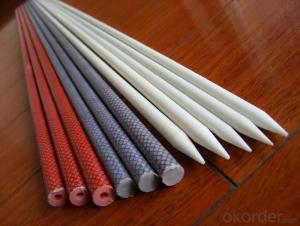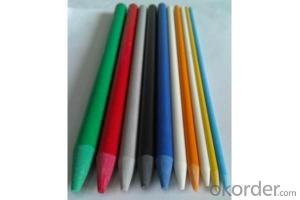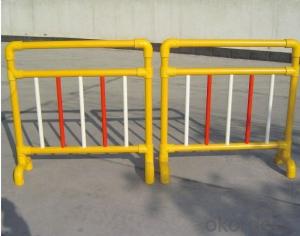Flexible Fiberglass Stick with Good Characteristics
- Loading Port:
- China Main Port
- Payment Terms:
- TT OR LC
- Min Order Qty:
- -
- Supply Capability:
- -
OKorder Service Pledge
OKorder Financial Service
You Might Also Like
Features of Flexible Fiberglass Stick with GoodCharacteristics:
Corrosion resistant
High strength & light weight
Long service life
Fire retardant
Impact resistant
Nonconductive and thermal insulation
Non-magnetic electromagnetic transparency
Dimensional stability, Bright color
Low-maintenance
Application of Flexible Fiberglass Stick with Good Characteristics:
1) Outdoor activities: tent Pole, kite Rod,arrow shaft, ski pole, fishing rod, golf shaft, sail batten,hockey stick, kickboard, skate boards, paddle shafts, bows and arrows, crossbows, golf shafts,slideguides, boat, kayak
2) Tool: umbrella shaft, umbrella rod, curtain rod,fence post, rail, handrail, frame for cases andbags, flag pole, oil suckerrods, bolts, stair, ladder, greenhouse structures, scaffold, portable workplatforms, cooling tower, luggage rack, window/door frame, sign post, bridgestructure,bus bar supports, tool handles, bike flags, flag poles, floorgratings, shoe soles, protectivecases for laptops and iPhones
3) Toys: model cars/planes/helicopters, unmannedaerial vehicles, formula-1 race car
4) Vehicle: motor top sticks, u-shaped motor statorwedges, service truck booms, snowmobiletrack stiffeners, high-endautomobile components, bicycle frames, glider, microcar, bodyshell,wind turbineblade
5) Pipe: gutters, firewater/ cooling water /gas/drinking water/ waste water pipe
6) Building: roofing laminate, flat roof, doorsurrounds, over-door canopies, window canopies anddormers, chimneys,coping systems, insulators, cable conductor, cable tray, antenna,transformer air duct spacer sticks, cable support trays,switch actuators
Technical Data Sheet of Flexible Fiberglass Stick with GoodCharacteristics:
Outer diameter * Inner diameter(special specifications, to open a separatemode):
3.0mm*1.5mm | 4.0mm*2.0mm | 4.0mm*2.5mm | 5.0mm*3.0mm | 5.0mm*3.5mm |
6.0mm*3.0mm | 6.0mm*4.0mm | 6.3mm*3.2mm | 6.5mm*4.0mm | 7.0mm*3.4mm |
8.0mm*4.0mm | 8.0mm*6.0mm | 8.5mm*4.2mm | 9.5mm*4.2mm | 9.5mm*6.0mm |
9.5mm*6.5mm | 10.0mm*6.5mm | 10.0mm*8.0mm | 11.1mm*5.5mm | 12.0mm*8.0mm |
12.5mm*6.0mm | 12.5mm*8.0mm | 12.7mm*6.0mm | 16.0mm*6.0mm | 16.0mm*10.0mm |
19mm*13mm | 25mm*19mm | 28mm*23mm | 30mm*20mm | 32mm*26mm |
39mm*31mm | 50mm*42mm | 60mm*45mm | 76mm*68mm |
|
- Q:Can FRP pultrusion profiles be used in architectural or decorative applications?
- Yes, FRP pultrusion profiles can be used in architectural or decorative applications. They offer various advantages such as high strength-to-weight ratio, resistance to corrosion and UV radiation, and design flexibility. Additionally, FRP pultrusion profiles can be customized to match specific aesthetic requirements, making them suitable for architectural and decorative purposes.
- Q:Can FRP pultrusion profiles be used in modular construction?
- Certainly, FRP (Fiber Reinforced Polymer) pultrusion profiles are a viable option for integration into modular construction. These profiles possess advantageous qualities, including a lightweight composition, exceptional strength, resistance to corrosion, and superb thermal and electrical insulating properties. These attributes make them an ideal choice for implementation in modular construction, where the focus is on prefabrication, transportation, and swift assembly. The utilization of FRP pultrusion profiles within modular construction yields numerous benefits. Firstly, their lightweight nature facilitates easy handling and transport, which consequently reduces logistical costs and effort. Secondly, their high strength-to-weight ratio ensures structural integrity without adding unnecessary weight to the modular components. This is especially advantageous in scenarios where weight reduction is critical, such as rooftop installations or areas with limited load-bearing capacity. Moreover, the corrosion resistance of FRP profiles eliminates the necessity for regular maintenance and enhances the longevity of the modular construction. This proves particularly advantageous in challenging environments, like coastal regions or chemical processing facilities, where traditional construction materials like steel may rapidly deteriorate. Furthermore, FRP pultrusion profiles can be easily tailored to fulfill specific design requirements. They can be manufactured in diverse shapes, sizes, and colors, granting flexibility in modular construction design. Additionally, these profiles can be seamlessly integrated with other construction materials, such as concrete or wood, ensuring compatibility with existing modular systems. To summarize, the lightweight nature, high strength, corrosion resistance, and customization capabilities of FRP pultrusion profiles make them highly suitable for modular construction. Their implementation in this field improves efficiency, reduces costs, and enhances the overall performance and durability of modular buildings and structures.
- Q:Can FRP pultrusion profiles be used in the aerospace industry?
- Yes, FRP (Fiber Reinforced Polymer) pultrusion profiles can be used in the aerospace industry. FRP materials offer several advantages that make them suitable for aerospace applications. Firstly, FRP profiles have high strength-to-weight ratios, which is crucial in the aerospace industry where weight reduction is a priority. Their lightweight nature allows for fuel efficiency and increased payload capacity. Secondly, FRP pultrusion profiles have excellent corrosion resistance, making them ideal for aerospace applications where exposure to harsh environments is common, such as high altitude, extreme temperatures, and moisture. This resistance to corrosion ensures the durability and longevity of the components, reducing maintenance and replacement costs. Additionally, FRP materials can be tailored to meet specific design requirements, enabling engineers to create complex shapes and structures with ease. This flexibility in design allows for enhanced performance and functionality in aerospace applications. Moreover, FRP pultrusion profiles exhibit excellent fatigue resistance, meaning they can withstand the cyclic loading and stress cycles that are common in aerospace operations. This characteristic ensures the reliability and safety of the components, which is of utmost importance in the aerospace industry. Furthermore, FRP materials offer electrical insulation properties, which can be advantageous in aerospace applications where electrical conductivity needs to be minimized or controlled. This insulation capability contributes to the overall safety and functionality of the components. In conclusion, FRP pultrusion profiles can indeed be used in the aerospace industry due to their high strength-to-weight ratios, corrosion resistance, flexibility in design, fatigue resistance, and electrical insulation properties. These qualities make FRP a viable and attractive choice for various aerospace applications, including aircraft structures, interior components, radomes, and others.
- Q:Are FRP pultrusion profiles resistant to chemicals used in pharmaceutical packaging?
- FRP pultrusion profiles exhibit a general resistance to chemicals commonly employed in pharmaceutical packaging. These profiles are composed of a blend of reinforced fibers and a polymer resin matrix, resulting in exceptional resistance to chemical substances. The polymer resin utilized in FRP profiles is typically chosen to be compatible with a wide array of chemicals, including those typically used in pharmaceutical packaging. The remarkable chemical resistance of FRP profiles has led to their widespread utilization in various sectors, pharmaceuticals included. They can endure exposure to an extensive range of chemicals, such as acids, bases, solvents, and other aggressive substances frequently encountered in pharmaceutical packaging procedures. This resistance effectively safeguards the packaging's integrity and ensures that the pharmaceutical products remain free from contamination or degradation. Moreover, FRP pultrusion profiles also possess corrosion resistance, which proves advantageous in the pharmaceutical industry where aggressive chemicals may be present. This corrosion resistance further bolsters the durability and longevity of the FRP profiles, establishing them as a dependable choice for pharmaceutical packaging applications. Nonetheless, it is essential to recognize that the specific chemical resistance of FRP pultrusion profiles may vary depending on the type and concentration of chemicals employed. Therefore, it is advisable to consult the manufacturer or supplier of the FRP profiles to ascertain their compatibility with the specific chemicals used in pharmaceutical packaging.
- Q:Can FRP pultrusion profiles be used in walkway systems?
- Yes, FRP (Fiber Reinforced Polymer) pultrusion profiles can be used in walkway systems. FRP pultrusion profiles are known for their high strength-to-weight ratio, corrosion resistance, and durability, making them an excellent choice for various applications, including walkway systems. The lightweight nature of FRP pultrusion profiles makes them easy to handle and install, reducing the overall construction time and cost. Additionally, their corrosion resistance ensures that they can withstand harsh environmental conditions, such as exposure to moisture, chemicals, and UV radiation, without deteriorating or requiring frequent maintenance. FRP pultrusion profiles can be customized to meet specific design requirements, allowing for the creation of walkway systems with different shapes, sizes, and load-bearing capacities. These profiles can be manufactured with anti-slip surfaces or integrated with other safety features to enhance the traction and prevent accidents on the walkways. Furthermore, FRP pultrusion profiles offer excellent electrical insulation properties, making them suitable for walkway systems in areas where electrical conductivity needs to be minimized, such as power plants or electrical substations. Overall, the unique properties of FRP pultrusion profiles make them a reliable and versatile material choice for walkway systems, offering long-lasting performance, low maintenance needs, and enhanced safety.
- Q:Can FRP pultrusion profiles be used in the construction of amusement park rides?
- Yes, FRP (Fiber Reinforced Polymer) pultrusion profiles can be used in the construction of amusement park rides. FRP pultrusion profiles offer numerous advantages that make them suitable for such applications. Firstly, FRP pultrusion profiles are known for their high strength-to-weight ratio. This means that they are significantly lighter than traditional materials like steel while still maintaining excellent structural integrity. As a result, using FRP profiles in amusement park rides can help reduce the overall weight of the structure without compromising on safety. Secondly, FRP pultrusion profiles have excellent corrosion resistance properties. Unlike steel, FRP does not rust or deteriorate when exposed to moisture or chemicals commonly found in amusement park environments. This makes FRP profiles ideal for rides that are constantly exposed to water, humidity, and other harsh conditions. Additionally, FRP pultrusion profiles offer design flexibility. They can be manufactured in various shapes and sizes, allowing for customized designs to meet specific requirements of amusement park rides. This versatility in design enables engineers and designers to create complex and intricate structures that are both aesthetically pleasing and functional. Moreover, FRP pultrusion profiles have excellent electrical insulation properties. This is particularly important for amusement park rides that may have electrical components and wiring, as FRP profiles can provide a high level of safety by preventing electrical conductivity. Furthermore, FRP profiles are non-magnetic, which can be advantageous in amusement park rides that use magnetic systems or sensors. Non-magnetic materials eliminate the risk of interference or disruption to the ride's functionality. Lastly, FRP pultrusion profiles are durable and require minimal maintenance. They are resistant to UV radiation, which means they will not degrade or fade due to prolonged exposure to sunlight. This reduces the need for frequent painting or coating, resulting in lower maintenance costs over time. Overall, the combination of lightweight, corrosion resistance, design flexibility, electrical insulation, non-magnetic properties, and durability make FRP pultrusion profiles an excellent choice for the construction of amusement park rides.
- Q:Do FRP pultrusion profiles require any special tools for installation?
- Yes, FRP pultrusion profiles do require special tools for installation. These tools typically include saws for cutting the profiles to size, drills for creating holes, and adhesive application tools for bonding the profiles to the substrate. Additionally, specialized fasteners and brackets may be needed to secure the profiles in place. It is important to use these tools correctly to ensure a proper and secure installation of FRP pultrusion profiles.
- Q:Can FRP pultrusion profiles be used in the construction industry?
- Indeed, the construction industry can utilize FRP (Fiber Reinforced Polymer) pultrusion profiles. These profiles offer numerous benefits that make them appropriate for diverse construction applications. To begin with, FRP pultrusion profiles possess exceptional strength while remaining lightweight. Consequently, they are an excellent choice for construction projects as they provide a high strength-to-weight ratio. This reduces the overall weight of the structure while preserving its structural integrity. This advantage is particularly valuable for applications like bridges, walkways, and platforms. Furthermore, FRP pultrusion profiles exhibit a high level of resistance to corrosion. Unlike conventional construction materials such as steel or wood, FRP does not rust, rot, or corrode when exposed to harsh environmental conditions, chemicals, or moisture. Consequently, FRP profiles are ideal for outdoor or marine applications where corrosion can be a concern, such as seawalls, docks, or offshore structures. In addition, FRP pultrusion profiles possess excellent electrical and thermal insulation properties. This makes them suitable for applications where minimizing electrical conductivity is necessary, such as electrical enclosures or cable trays. Moreover, FRP profiles have low thermal conductivity, which enhances energy efficiency in buildings by reducing heat transfer. Furthermore, FRP pultrusion profiles are highly durable and require minimal maintenance. They boast a long service life and do not necessitate regular painting, sealing, or treatment like traditional materials. Consequently, significant cost savings can be achieved throughout the life cycle of a construction project. Lastly, FRP pultrusion profiles can be customized to meet specific strength, stiffness, and dimensional requirements. They can be produced in various shapes, sizes, and colors, allowing for flexibility in design. This versatility renders FRP profiles suitable for a wide range of construction applications, including beams, columns, gratings, handrails, and structural components. To summarize, FRP pultrusion profiles are a viable choice for the construction industry due to their lightweight nature, high strength, corrosion resistance, electrical and thermal insulation properties, durability, low maintenance requirements, and design flexibility.
- Q:How do FRP pultrusion profiles compare to traditional materials, such as steel or aluminum?
- FRP pultrusion profiles offer several advantages over traditional materials like steel or aluminum. Firstly, FRP profiles are much lighter in weight, making them easier to handle and install. Additionally, FRP profiles possess excellent corrosion resistance, making them a suitable choice for applications in harsh environments. They also have high strength-to-weight ratio, allowing for efficient load-bearing capabilities. Furthermore, FRP profiles are non-conductive and do not require any additional insulation, making them ideal for electrical applications. Lastly, FRP profiles are highly customizable, enabling the design of complex shapes and sizes. Overall, FRP pultrusion profiles provide a cost-effective, durable, and versatile alternative to traditional materials.
- Q:Can FRP pultrusion profiles be used in telecommunications towers?
- Yes, FRP (Fiber Reinforced Polymer) pultrusion profiles can be used in telecommunications towers. FRP pultrusion profiles offer several advantages that make them suitable for this application. Firstly, FRP profiles are lightweight yet strong, allowing for easy installation and reduced structural weight in telecommunications towers. This is important as it helps to minimize the overall weight load on the tower structure. Secondly, FRP pultrusion profiles have excellent corrosion resistance properties, making them ideal for outdoor applications like telecommunications towers, which are exposed to various environmental conditions. Unlike traditional materials such as steel or wood, FRP profiles do not rust, rot, or degrade when exposed to moisture, UV radiation, or chemicals typically found in outdoor environments. Additionally, FRP pultrusion profiles offer excellent electrical insulation properties, which is crucial in telecommunications towers. These profiles do not conduct electricity, reducing the risk of electrical interference or short circuits that could disrupt the tower's communication systems. Furthermore, FRP pultrusion profiles can be manufactured in various shapes and sizes, allowing for customization and meeting specific design requirements of telecommunications towers. This versatility allows for better integration and compatibility with other tower components. Overall, the combination of lightweight, high strength, corrosion resistance, electrical insulation, and customization options make FRP pultrusion profiles a viable and advantageous choice for use in telecommunications towers.
1. Manufacturer Overview |
|
|---|---|
| Location | |
| Year Established | |
| Annual Output Value | |
| Main Markets | |
| Company Certifications | |
2. Manufacturer Certificates |
|
|---|---|
| a) Certification Name | |
| Range | |
| Reference | |
| Validity Period | |
3. Manufacturer Capability |
|
|---|---|
| a)Trade Capacity | |
| Nearest Port | |
| Export Percentage | |
| No.of Employees in Trade Department | |
| Language Spoken: | |
| b)Factory Information | |
| Factory Size: | |
| No. of Production Lines | |
| Contract Manufacturing | |
| Product Price Range | |
Send your message to us
Flexible Fiberglass Stick with Good Characteristics
- Loading Port:
- China Main Port
- Payment Terms:
- TT OR LC
- Min Order Qty:
- -
- Supply Capability:
- -
OKorder Service Pledge
OKorder Financial Service
Similar products
New products
Hot products
Related keywords




























